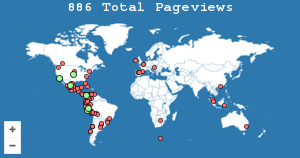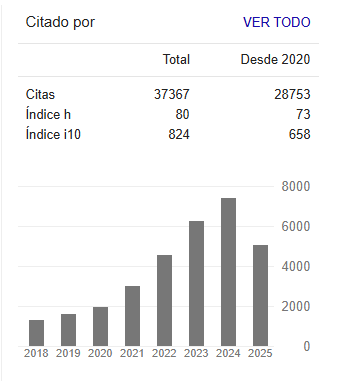Market segmentation and perceived value in the gastronomy industry of Medellin, Colombia: an empirical study
Resumen
This study examines market segmentation within the gastronomic industry in Medellín, Colombia, focusing on perceived value, consumer types, and brand positioning among young adults. Using a mixed-method approach with a sequential exploratory design, focus groups were conducted to identify key attributes valued by consumers. This data was the base for a subsequent quantitative survey, which delineated three distinct market segments characterized by their preferences for connectivity, cleanliness, reasonable prices, ambiance, quality of service, variety in dishes, portion size, and service time. The results suggest that young adults in Medellín prioritize a combination of quality and experience factors in their gastronomic choices. The conclusions highlight sociodemographic differences, such as the tendency of women to seek information about establishments before visiting the establishments or the preference of middle-class youth for casual dining restaurants, results that contribute to marketing management and tourism decision-making.
Citas
Aldás, J., & Uriel, E. (2017). Análisis multivariante aplicado con R (Paraninfo, Vol. 2).
Asghar, M., Ting, D. H., Salim, L., & Ahmad-Ur-Rehman, M. (2021). Influence of servicescape on behavioural intentions through mediation and moderation effects: A study on Malaysia’s full-service restaurants. Cogent Business and Management, 8(1). https://doi.org/10.1080/23311975.2021.1924923
Ayuningtyas, F., & Uljanatunnisa, U. (2019). SOCIAL SCIENCES & HUMANITIES. The Power of Word of Mouth to Establish Brand Positioning (A Case Study of the House of Raminten as a Modern Style of Angkringan Traditional in Yogyakarta, Indonesia). Pertanika J. Soc. Sci. & Hum, 27(2), 1325–1337.
Belarmino, A., Ozdemir, O., & Dogru, T. (2021). Always local? Examining the relationship between peer-to-peer accommodations and restaurants. Journal of Hospitality and Tourism Management, 48, 289–300. https://doi.org/10.1016/j.jhtm.2021.07.003
Canny, I. (2014). Measuring the Mediating Role of Dining Experience Attributes on Customer Satisfaction and Its Impact on Behavioral Intentions of Casual Dining Restaurant in Jakarta. International Journal of Innovation, Management and Technology, 5(1). https://doi.org/10.7763/ijimt.2014.v5.480
Castro, S. (2021). ¿Cómo les fue a los bares y restaurantes colombianos en 2020? Bancolombia.
Chang, R. C. Y., Kivela, J., & Mak, A. H. N. (2011). Attributes that influence the evaluation of travel dining experience: When East meets West. Tourism Management, 32(2), 307–316. https://doi.org/10.1016/j.tourman.2010.02.009
Coca, M. (2007). Importancia y concepto del posicionamiento una breve revisión teórica. PERSPECTIVAS, (20), 105-114. https://www.redalyc.org/pdf/4259/425942331007.pdf
Cooper, K., Dedehayir, O., Riverola, C., Harrington, S., & Alpert, E. (2022). Exploring consumer perceptions of the value proposition embedded in vegan food products using text analytics. Sustainability, 14(4), 2075. doi:https://doi.org/10.3390/su14042075
Cámara de Comercio Medellín (2021). Clúster Turismo de Negocios. https://www.camaramedellin.com.co/comunidad-cluster/comunidad-cluster/cluster-turismo-de-negocios
Daabes, A. S. A., & Kharbat, F. F. (2017). Customer-based perceptual map as a marketing intelligence source. Int. J. Economics and Business Research, 13(4).
Departamento Administrativo Nacional de Estadística. (2017). Comunicado de prensa. Producto Interno Bruto (PIB) Tercer trimestre 2017. https://www.dane.gov.co/files/investigaciones/boletines/pib/cp_PIB_IIItrim17_oferta.pdf
Departamento Administrativo Nacional de Estadística. (2018). Boletín técnico. Producto Interno Bruto (PIB) 2018. https://www.dane.gov.co/files/investigaciones/boletines/pib/bol_PIB_IIItrim18_producion.pdf
Departamento Administrativo Nacional de Estadística. (2019). Comunicado de prensa. Producto Interno Bruto (PIB) 2019. https://www.dane.gov.co/files/investigaciones/boletines/pib/cp_PIB_IIItrim19.pdf
Departamento Administrativo Nacional de Estadística. (2020). Comunicado de prensa Resultados EMC, EMMET, EMS y EMA. https://www.dane.gov.co/files/comunicados/comunicado-economicas-agosto-2020.pdf
Dodds, R., & Holmes, M. R. (2017). Local Versus Visitor Perceptions of Farmers’ Markets. Journal of Food Products Marketing, 23(2), 167–185. https://doi.org/10.1080/10454446.2017.1244785
Ferreira, S. D., Real, E., & Rial, A. (2011). Aplicación del escalamiento multidimensional al marketing turístico. Estudios y Perspectivas en Turismo, 20, 21–33.
Galvis, V., Bustamante, M., & Sarmiento, C. A. (2023). Norma técnica para la detección temprana de las alteraciones del desarrollo del joven de 10 a 29 años. https://www.minsalud.gov.co/sites/rid/Lists/BibliotecaDigital/RIDE/VS/PP/7Deteccion%20temprana%20alteraciones%20joven.pdf
Ge, Y., Yuan, Q., Wang, Y., & Park, K. (2021). The structural relationship among perceived service quality, perceived value, and customer satisfaction-focused on starbucks reserve coffee shops in Shanghai, China. Sustainability (Switzerland), 13(15). https://doi.org/10.3390/su13158633
Gorard, S. (2013). Research Design: Creating Robust Approaches for the Social Sciences (K. Metzler, Ed.; SAGE, Vol. 1).
Gutiérrez, E. (2020). Crisis sacude a los restaurantes de Medellín. El Tiempo. https://www.eltiempo.com/colombia/medellin/crisis-sacude-a-los-restaurantes-de-medellin-525128
Lambin, J.J., Gallucci, C., & Sicurello, C. (2009). Dirección de Marketing. Gestión Estratégica y Operativa del Mercado (J. Mares Chacón & R. A. Bosque Alayón, Eds.; Mc Graw Hill, Vol. 2).
Jeong, E. H., & Jang, S. C. S. (2011). Restaurant experiences triggering positive electronic word-of-mouth (eWOM) motivations. International Journal of Hospitality Management, 30(2), 356–366. https://doi.org/10.1016/j.ijhm.2010.08.005
Johnston, J. W., & Marshall, G. W. (2009). Administración de Ventas (J. Mares Chacón & R. Bosque Alayón, Eds.; Mc Graw Hill, Vol. 9).
Kazbare, L., van Trijp, H. C. M., & Eskildsen, J. K. (2010). A-priori and post-hoc segmentation in the design of healthy eating campaigns. Journal of Marketing Communications, 16(1–2), 21–45. https://doi.org/10.1080/13527260903342712
Kotler, P. (2012). Dirección de Marketing (G. Domínguez Chávez & B. Gutiérrez Hernández, Eds.; Pearson Education, Vol. 14).
Kotler, P., & Armstrong, G. (2008). Principios de Marketing (A. Cañizal, Ed.; Pearson, Vol. 11).
Kwak, M. K., Lee, J., & Cha, S. S. (2021). Senior consumer motivations and perceived value of robot service restaurants in Korea. Sustainability (Switzerland), 13(5), 1–16. https://doi.org/10.3390/su13052755
Marcoulides, G. A., & Schumacker, R. E. (2001). Item parceling issues in structural equation modeling. In New developments and techniques in structural equation modeling (pp. 269–296).
Marinho, C. de S., Almeida, S. de L., & Salazar, V. S. (2017). Uma xícara de Café? ¿A importância dos atributos de uma cafeteria na decisão de consumoA cup of coffee? The relevance of the attributes of a cafeteria in the consumption decisión Una taza de café? Hospitalidades, 14(2), 1–24.
Medellín cómo vamos. (2020) Medellín y Valle de Aburrá registran tasa de desempleo más alta de los últimos 18 años. Portal Medellín Cómo Vamos. https://www.medellincomovamos.org/desempleo-en-medellin-covid19
El tiempo (2018). El sector gastronómico en Medellín también llena los bolsillos. Medellín - Colombia. Periódico El Tiempo. https://www.eltiempo.com/colombia/medellin/el-sector-gastronomico-en-medellin-tambien-llena-los-bolsillos-156114
Mohd, N. (2017). Green products usage: structural relationships on customer satisfaction and loyalty. International Journal of Sustainable Development and World Ecology, 24(1), 88–95. https://doi.org/10.1080/13504509.2016.1169563
Mohd, Y. L., Wan Jusoh, W. J., & Maulan, S. (2021). Perceived quality association as determinant to re-patronise Shariah-compliant brand restaurants. Journal of Islamic Marketing, 12(2), 302–315. https://doi.org/10.1108/JIMA-10-2018-0190
Musa, M. I., Ikhwan, M., Haeruddin, M., Ilham, M., Haeruddin, W., & Burhan, M. I. (2019). Analysis of Segmentation, Targeting, and Positioning in the Hospitality Sector: The Case of Paputo Beach Café. African Journal of Hospitality, Tourism and Leisure, 8(4). https://www.semanticscholar.org/paper/Analysis-of-Segmentation%2C-Targeting%2C-and-in-the-The-Musa/dcce9a6e42c1feffb38df8f44683f22bc6ed6eae
Pérez-Villarreal, H. H., Martínez-Ruiz, M. P., Izquierdo-Yusta, A., & Gómez-Cantó, C. M. (2020). Food values, benefits and their influence on attitudes and purchase intention: Evidence obtained at fast-food hamburger restaurants. Sustainability (Switzerland), 12(18). https://doi.org/10.3390/SU12187749
Poulter, H., & Bolton, R. (2023). Embedding broader values in the regulatory model: An analysis of Ofgem’s consumer value proposition for the natural gas distribution sector. Utilities Policy, 80, 101470. https://doi.org/10.1016/j.jup.2022.101470
Rabanal de Dios, A. (2021). Factores influyentes en la intención de visitar un restaurante de lujo. [Universidad del Pais Vasco]. https://addi.ehu.es/handle/10810/55316
Reuters. (2023). Colombia to hikie mínimum wage by 12% in 2024. Thomson Reuters. https://www.reuters.com/world/americas/colombia-hike-minimum-wage-by-12-2024-2023-12-30/
Rodríguez-López, M., Aalcántara-Pilar, J. M., & Rojas-Lamorena, Á. O. J. (2020). Dining experience in the restaurant: Theoretical and empirical delimitation for two types of establishments. Cuadernos de Gestión, 20(1). https://doi.org/10.5295/CDG.180904MR
Ryu, K., Han, H., & Kim, T. H. (2008). The relationships among overall quick-casual restaurant image, perceived value, customer satisfaction, and behavioral intentions. International Journal of Hospitality Management, 27(3), 459–469. https://doi.org/10.1016/j.ijhm.2007.11.001
Semana. (2020). ¿Cómo va la reactivación del sector gastronómico en Colombia? Revista Semana. https://www.semana.com/nacion/articulo/como-va-la-reactivacion-del-sector-gastronomico-en-colombia/202009/
Siyal, S., Ahmed, M. J., Ahmad, R., Khan, B. S., & Xin, C. (2021). Factors influencing green purchase intention: Moderating role of green brand knowledge. International Journal of Environmental Research and Public Health, 18(20). https://doi.org/10.3390/ijerph182010762
Slack, N. J., Singh, G., Ali, J., Lata, R., Mudaliar, K., & Swamy, Y. (2021). Influence of fast-food restaurant service quality and its dimensions on customer perceived value, satisfaction and behavioural intentions. British Food Journal, 123(4), 1324–1344. https://doi.org/10.1108/BFJ-09-2020-0771
Slater, M. D. (1996). Theory and method in health audience segmentation. Journal of Health Communication, 1(3), 267–283. https://doi.org/10.1080/108107396128059
Sousa, R., Horta, C., Ribeiro, R., & Rabinovich, E. (2020). How to serve online consumers in rural markets: Evidence-based recommendations. Business Horizons, 63(3), 351-362. https://doi.org/10.1016/j.bushor.2020.01.007
Stalgaitis, C. A., Jordan, J. W., Djakaria, M., Saggese, D. J., & Robbins Bruce, H. (2022). Psychographic segmentation to identify higher-risk teen peer crowds for health communications: Validation of Virginia’s Mindset Lens Survey. Frontiers in Public Health, 10, 871864. https://doi.org/10.3389/fpubh.2022.871864
Tukker, A., & Tischner, U. (2006). Product-services as a research field: Past, present, and future. Reflections from a decade of research. Journal of Cleaner Production, 14(17), 1552-1556. https://doi.org/10.1016/j.jclepro.2006.01.022
Varela, J., García, A., Braña, T., & Rial, A. (2002). Imagen y posicionamiento de establecimientos minoristas. Psicothema, 14(1), 92–99. http://psicothema.com/pdf/691.pdf
Varón, D., & Daza, C. (2022). Estilos de vida en millennials. Boletín de Antropología, 37(63), 23. https://doi.org/10.17533/udea.boan.v37n63a9
Wu, C. H. J., & Liang, R. Da. (2009). Effect of experiential value on customer satisfaction with service encounters in luxury-hotel restaurants. International Journal of Hospitality Management, 28(4), 586–593. https://doi.org/10.1016/j.ijhm.2009.03.008
Yeo, G. E., Cho, M. S., & Oh, J. (2020). Food-related lifestyle segmentation and beverage attribute’ selection: toward understanding of sugar-reduced beverages choice. British Food Journal, 122(12), 3663–3677. https://doi.org/10.1108/BFJ-10-2019-0817
Zapata, M. (2020). El Sector gastronómico se reactiva a través de experiencias virtuales. TeleMedellín. https://telemedellin.tv/el-sector-gastronomico-se-reactiva-a-traves-de-experiencias-virtuales/402918/
Zhang, Z., Ye, Q., Law, R., & Li, Y. (2010). The impact of e-word-of-mouth on the online popularity of restaurants: A comparison of consumer reviews and editor reviews. International Journal of Hospitality Management, 29(4), 694–700. https://doi.org/10.1016/j.ijhm.2010.02.002

Esta obra está bajo licencia internacional Creative Commons Reconocimiento-NoComercial-CompartirIgual 4.0.








.png)






























